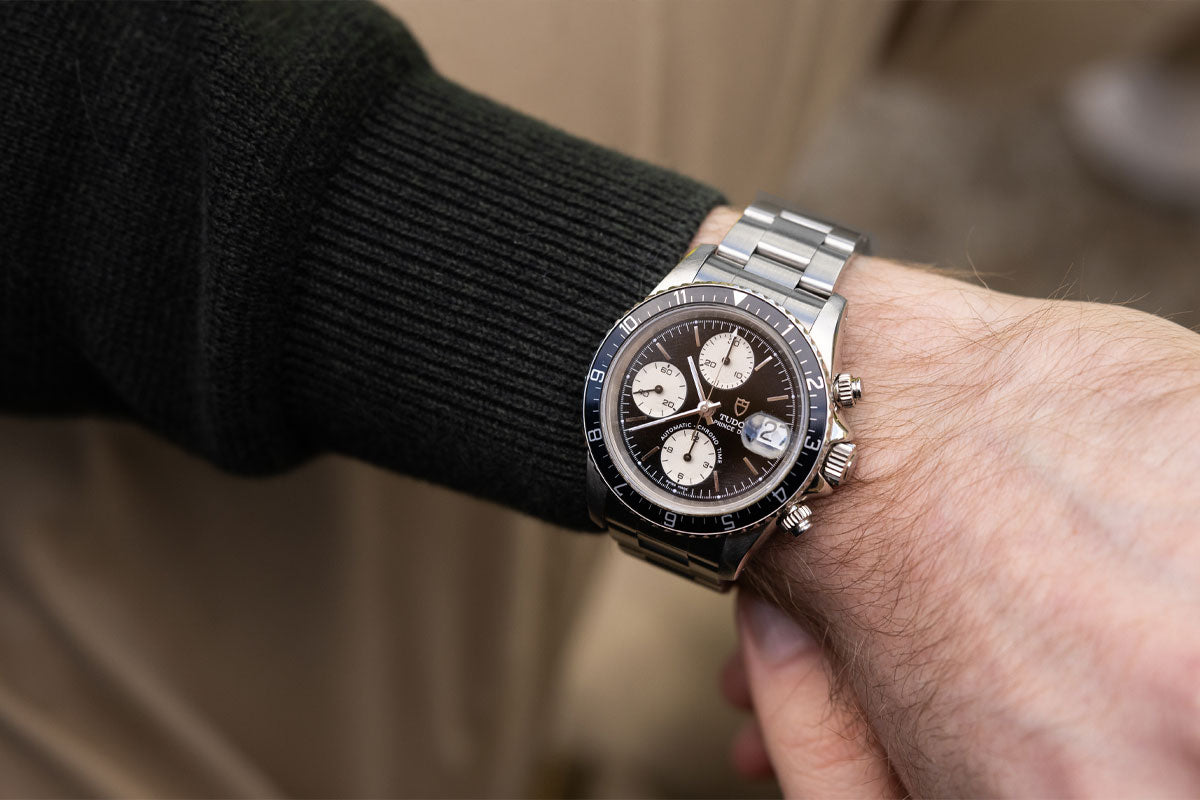The Tudor Origin Story from 1926 to 1969

“For some years now, I have been considering the idea of making a watch that our agents could sell at a more modest price than our Rolex watches, and yet one that would attain the standard of dependability for which Rolex is famous. I decided to form a separate company, with the object of making and marketing this new watch. It is called the TUDOR watch company.” - H. Wilsdorf
In February 1926 the brand was born, in Geneva, where a watch dealer and maker registered the trademark “The TUDOR” for Hans Wildorf. Hans Wildorf would effectively guarantee, via the Rolex brand, the aesthetic and robustness of the TUDOR watches until the brand attained autonomy.
It was slightly later on, in 1932 that the first watches were created and made available for sale. They had a simple TUDOR signature on the dial with the horizontal bar on the T lengthened above the other letters. You may also see some rare examples where the Rolex name also appears.
These first watches were ‘CATANACH’S’, rectangular watches with bevelled sides in chromium-plated metal. They featured a cream two-tone, two-sector, dial with luminescent Arabic numbers with blued steel hands.
Catanach’s Jewellers were established in Melbourne in 1874, and are one of the longest standing jeweller families in Australia. They were exclusive distributors for the brand.
Shortly after, in 1936, Hans Wilsdorf took back ‘The TUDOR’ brand from the original registrant. It was at this point that the iconic rose of the TUDOR dynasty appeared on the dials. This rose, inscribed within a shield, was to symbolise the invincible union of strength (the watch’s robustness) and grace (the watch’s beauty).
In 1946, shortly after the Second World War, Hans Wilsdorf formalised the brand by registering the “Montres TUDOR S.A.” company. The goal was to specialise in models for both men and women. Rolex would continue to guarantee the watches technical, and aesthetic characteristics; as well as the general distribution and any required after-sales service.
From 1947 onwards the logo evolved. The shield was removed from the logo, leaving just the iconic TUDOR rose.
In 1952 the TUDOR Oyster Prince was launched…..
“I have decided that the TUDOR Prince deserves to share with Rolex two advantages I would allow no other watch to use – the famous and unique waterproof Oyster case and the original self-winding Perpetual ’rotor’ mechanism. All TUDOR Oyster Princes will have these two exceptional features, previously exclusive to Rolex. This indicates, I think, the measure of our faith in the new watch. I am proud to give my personal endorsement.” - Hans Wilsdorf
Shortly after launch, 26 of these watches were taken on the British scientific expedition to Greeland organised by the Royal Navy. Proving the brands commitment to the strength, reliability, and precision of the products.
They didn’t stop there…
In 1953 a series of advertisements were launched to cement their commitment to robustness of the TUDOR Oyster Prince.
-watch worn by a coal miner during 252 hours of excavation by hand
-watch subjected to the vibrations of a pneumatic drill for 30 hours
-watch worn by a stonecutter for three months
-watch worn for a month while riveting metal girders in building construction
-watch worn by a motorbike racer over a distance of 1,000 miles.
Emphasis was placed on the great strength of the watches, their precision, their efficient winding and their waterproofness even in extreme conditions.
Following the initial success of the Oyster Prince, TUDOR did something that the TUDOR/Rolex companies are famous for. Unique dials.
The TUDOR “Tuxedo”, reference 7950 was launched which had a two-colour dial in black and white. The central decoration was enamelled paint with a vertical and horizontal line dividing the dial up in to ‘sectors’. It is surrounded by a metal insert with guilloche decorations. This black and white design recalls the classic colours of a tuxedo, hence the name.
In 1957 Tudor released their first alarm watch, the ‘Tudor Advisor’. To this day, it’s one of the brands most atypical model. Initially there were two models, the 7926 and 1537; both using the Oyster-type case. In 1969 they released a third model that had a dedicated case, this was the reference 10050. In 2011 the legendary alarm watch got a ‘reboot’ with the release of the reference 79620T. This was entirely redesigned, and sized for the modern era as it grew 8mm to 42mm (from the original 34mm).
In 1961 Tudor released the Tudor Royal reference 8533. This ladies watch was 9ct gold and showed that the brand was able to offer a refined, and stylistic, ladies watch.
In the 1960s’ (but only appearing in the catalogue in 1969 for the first time) the iconic Tudor Oyster Prince Ranger reference 7995/0 was released, remaining in the catalogue until 1988. They came with a 34 mm waterproof steel case. The dial was matte black with the rose logo, punctuated with luminous rectangular hour markers and luminous Arabic numerals at 3, 6, 9 and 12 o’clock. The steel Oyster-type bracelet (reference 7835) has folding links and a Rolex signed clasp.
This is a watch that was re-issued in 2022 to mark the 70th anniversary of the British North Greenland expedition. The reference 79950 Tudor Ranger grew from 34mm to 39mm but retained the iconic dial, and hand, design that made the original 7995/0 so iconic.
From 1969 onwards, with the principles of a classic aesthetic established beyond doubt and the brand’s production moving increasingly towards robust and technical products, the rose disappeared from the logo in favour of the shield – a symbol of solidity and unfailing reliability.
1969 also saw the launch of the Tudor Oyster Prince Date+Day 7017/0. This was one of the largest watches in the Prince model line at 37.5mm. A popular reference that came with a variety of dial colours, something that makes Rolex and Tudor watches so collectable due to the variety.






